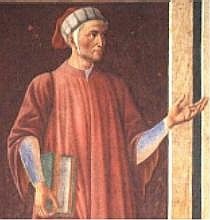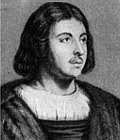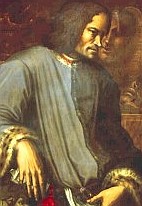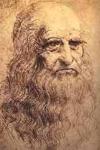out of the dark
a quick history of italian literature
By Roberto Simmarano

The origins of Italian Literature
The rise of a literature, both written and spoken, in the vernacular began in the 13th
century; a period of great political and civil revival in the Italian cities and a lively
renaissance in art and culture after the difficult centuries following barbarian domination.
There were a great number of trends in 13th-century literature: religious poetry (which
thrived in Umbria partly as a result of the activity of Saint Francis, especially with the
work of Jacopone da Todi); poetry made popular by the French jongleurs; the comic-satirical
poetry of Cecco Angiolieri; chivalric literature (the chansons de geste derived from the
French); didactic and moralistic prose in which Brunetto Latini was prominent, and, the most
widespread, love poetry.
The Sicilian and Tuscan poets
The first Italian poetry written with literary pretensions emerged, and flourished in Sicily
at the Court of the Emperor Frederick II, starting from around 1220 and inspired
by the Provencal love lyrics. The poets of the Sicilian school (Guido delle Colonne, Pier
dela Vigna, Cielo Dalcamo) treated their single theme of love according to the courtly
model. In this way a poetic tradition was begun in which the vernacular Italian was increasingly
cleansed of dialectical excess. Later this trend spread to central Italy, especially Tuscany
where the poets (Chiaro Davanzati, Compiuta Donzella) expanded and enriched the Sicilian lyric
by confronting moral and political themes which reflected the ideals of Communal life.
Stil Novo
The most important literary movement of the latter half of the 13th century was what Dante called
the "dolce stil novo". The dominant theme of the poets (Guido Guinizelli, Guido Cavalcanti)
was the basic experience of the conscience and the life of the soul. What was new about the style was
not simply a more spiritual conception of woman, exalted as an angel of salvation, but a
deeper intellectual and philosophical examination of love as the source of moral virtue,
and a more refined searching of the psyche.
Dante Alighieri (1265-1321)
The 14th century was a period of gradual change in Medieval life and culture which gave rise
to a new concept of existence. It also saw a maturing of the literary tradition which was given
its greatest expression by the Florentine Dante Alighieri. Dante's work was the origin to the modern
Italian literary and linguistic tradition. The early lyrics are collected in the "Vita Nuova",
an idealized autobiography in which the poet sings of his love for Beatrice whilst at the same
time transcending that love for a higher one: the love of God. In the other works prior to the
"Divine Comedy" ("Convivio","De vulgari eloquentia", "De monarchia"), Dante deals with contemporary
themes of the spirit, culture, and politics.
Dante's "Divine Comedy"
Dante's major work, and the greatest in Italian literature is the "Divine Comedy": a complex and
highly poetic work treating a vast subject. The content unites the culture and spirit of the
Middle Ages and expresses a religious faith in a universe built and run by God's will. Dante's vision is
of a journey in the afterlife through Hell, Purgatory, and Paradise where he encounters the souls
of the great men of the past and discusses with them the most important themes of humanity:
philosophy, religion and morality, politics and culture. Dante's voyage, guided by Virgil (human
reason), and Beatrice (human reason enlightened by revelation), is also the story of his personal
redemption as well as a cry for the salvation of humanity.
Francesco Petrarca (Petrarch) (1304-1374)
Petrarch differed from Dante in that he actively confronted the division between austere Medieval
religion and the enjoyment of worldly goods, particularly love and fame. In this he was a precursor of
the Humanist thought of the Renaissance with its full evaluation of earthly existence. Petrarch
was the author of numerous philosophical, religious and poetic works in Latin, but his major works, I Trionfi,
and Il Canzoniere, are written in the vernacular. In the latter collection of poems, he
examines his soul, analyses his unrequited love for Laura (whoever the lady may have been) and probes
his inner - unresolved - crises.
 Giovanni Boccaccio (1313-1375)
Giovanni Boccaccio (1313-1375)
Boccaccio can be ranked alongside Dante and Petrarch as one of the three great Italian literary figures
of the 14th century who were also prominent on the European Scene. He can be distinguished from them,
however by his greater concentration on earthly themes and subjects and his relative disinterest in moral,
religious, theological and political issues. Boccaccio's greatest work is "The Decameron", a collection
of 100 tales linked in a narrative framework, where he masterfully portrays different characters and
their various passions, thus creating a vivacious image of life in all its many facets.
14th-Century Prose
The prose of the 14th century was characterized by an explosion of religious literature, primarily aimed
at the education and religious instruction of the people. The number of sermons, doctrinal treatises,
biographies of saints (particularly centered around Saint Francis and Saint Catherine) written at this
time are testimony to the degree to which Christianity had become rooted in contemporary conscience and
culture. There were also numerous historical works, in both Latin and Italian. These "chronicles" are
notable for their liveliness and concrete narration.
Humanism in the 15th Century
The 15th century saw the rise and confirmation of a spiritual and cultural movement characterized by the
rediscovery of the Greek and Latin classics, seen not only as the model for artistic perfection but also as a lesson
for life. The Italian Humanists believed that the Classical world offered them a view of reality that could serve them
in their own lives, one which exalted the dignity and rationality of Man, the glory of his spirit, the beauty of
Nature and worldly existence. There were many writers (Pico della Mirandola, Leonardo Bruni, Poggio Bracciolini and
Marsilio Ficinio in Florence, Giovanni Pontano and Jacopo Sannazzaro in Naples) who used themes and forms taken from
the past, thereby giving rise to Classicism.
 Lorenzo de' Medici (1449-1492)
Lorenzo de' Medici (1449-1492)
Fourteenth-century lyric poetry was the literary expression of a civilization still in its first flowering. The
prevalent themes were a realization of the beauty of the world and an optimistic faith in Man and Nature. A new
conception of life was expressed, one which involved a deeply-felt love for earthly reality faintly tinged by that
melancholy born of the awareness of the mutability of beauty, youth and life itself. These sentiments are evident
in the writings of Lorenzo de' Medici, the Florentine patron and friend of the poets as well as a poet himself.
Angelo Ambrogini (Politian) (1454-1494)
What emerges from the life and poetry of Politian is a desire and need to escape everyday realities and seek refuge
in a fantastical world of ideal beauty and harmony similar to that created by the great poets of the past. As a
result, his verses have an elevated literary tone and use forms and images influenced by the Classic writers. In his
poetry (the most famous perhaps being the "Stanze per la giostra", dedicated to Giuliano de' Medici) one is aware of
the poet's tendency to look idyllically upon himself while at the same time there is evidence of the focus on a new
harmony between Man and Nature; the fascination of life and the world as a whole; the cult of beauty and of poetry that
were all to characterize the Renaissance.
Luigi Pulci (1432-1484)
Alongside the refined Classicizing poetry of Politian and the varied, imaginative works of Lorenzo de' Medici, the
15th century also witnessed a return to 13th century chivalrous poetry, or rather a remodeling of heroic poetry.
In "Morgante Maggiore", Luigi Pulci uses the foundation of a chivalrous poem to build a work that was closer to the
ridiculing and burlesquing tone popular in Florence since the 13th century. The heroic passions of the warriors,
their noble deeds and idealistic love stories which form the basis of the heroic tradition are only an excuse for Pulci
to free his imagination and recite the most incredible stories and to describe human beings and their feelings in a
vivid and realistic way.
Matteo Maria Boiardo (1434-1494)
One of the major authors of 15th century Italian chivalric literature, along with Pulci, was Matteo Maria Boiardo, and
he too altered the traditional models. In his unfinished "Orlando innamorato", Boiardo, Count of Scandiano, brings
the uncurbable force of love to the rigid Carolingian world and uses it as a departure-point for a number of adventure
stories. The courtly tradition, as in Pulci's work, is deprived of its original religious, ethical and patriotic
content and transformed into an expression of the values and ideals of contemporary society.
 Humanistic prose: Leonardo da Vinci and Leon Battista Alberti
Humanistic prose: Leonardo da Vinci and Leon Battista Alberti
Da Vinci (1452-1519) and Alberti (1404-1472) were both thinkers and artists whose sweeping interests embody the
spiritual ideals and morals of the century. More than any other, da Vinci represents the ideal Renaissance man,
versatile and open to all experience; his genius found expression in painting, sculpture, philosophy, mathematics
and the study of the sciences, but he was also important as a writer thanks to his treatise on painting. Leon Battista
Alberti was another man of many talents: architect, theorist, mathematician, physicist and scholar, as well as
the author of treatises on sculpture and architecture, written in both the vernacular and Latin.
Next month we'll move into the Renaissance and touch on the battle of the dialects.




 Giovanni Boccaccio (1313-1375)
Giovanni Boccaccio (1313-1375)
 Lorenzo de' Medici (1449-1492)
Lorenzo de' Medici (1449-1492)
 Humanistic prose: Leonardo da Vinci and Leon Battista Alberti
Humanistic prose: Leonardo da Vinci and Leon Battista Alberti